By: Erin Osborn
Day two in Berlin brought our group to the most emotionally challenging part of our trip yet. Today we visited Sachsenhausen Concentration Camp. On the way there we met our guide Finn, who proved to be very knowledgeable and informative, yet appropriately personable. We boarded a train from Berlin to the town that the camp is located in, and we walked the same two-mile trek that the prisoners marched. Finn mentioned that yes there are new buildings, but for the most part the architecture that we saw throughout the town was the very same that the prisoners had seen. What immediately stuck out to me was how pretty and quiet the streets are, and just imagining the numerous victims trudging through them didn’t make sense. How could the people of the town stand to see this? After all, the camp was not isolated. In fact, it was practically in their backyards.
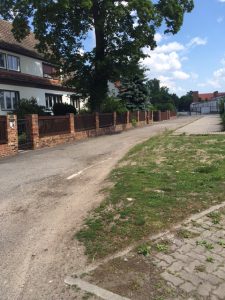
Upon our arrival, we learned that Sachsenhausen was established in 1936 and it was the first camp to be built. Finn pointed out a building that he said was probably one of the most important buildings of the time. This was where new concentration camps were planned.
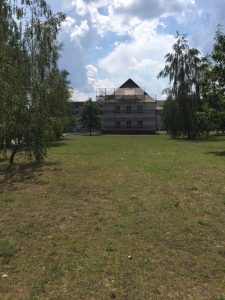
After a bathroom break and a brief overview of German history, we finally walked through the gate leading into the camp. Finn mentioned that there was only one addition to the gate – the clock on top.
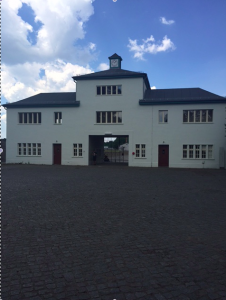
The clock was permanently set to 11:07 to commemorate the exact time the Soviets arrived and liberated the camp in 1945. Most of the 35,000 prisoners had already been evacuated on a death march by this time, but about 3,000 were too sick to walk and they were left behind. There are six mass graves just inside the camp to the side, and each holds around 50 bodies of these 3,000. I have a picture of one of these graves but the file size is too large to upload.
We toured the central watchtower above the gates, and through the windows every part of the camp was visible. Sachsenhausen was built in the shape of a triangle for maximum visibility by the guards. This watchtower along with several smaller ones positioned along the walls ensured nothing in the camp was out of sight. Again, I have a panoramic video of the view from the watch tower, but sadly the file is too large to upload.
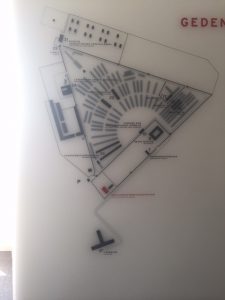
Sachenhausen wasn’t a death camp, but this does not mean that killings did not take place. In fact, it was actually one of the first places to experiment with fixed gas chambers. As we passed by a pit where prisoners were taken to be shot and as we walked through the foundation of what was once a gas chamber and a furnace where the victims’ bodies were cremated, many in the group were moved to tears.
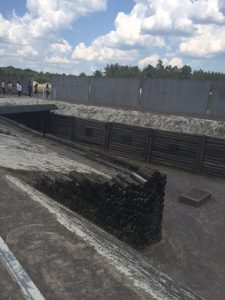
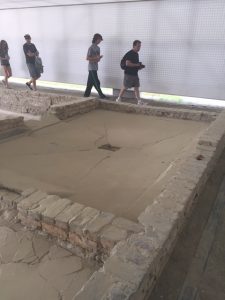
Something Finn talked about particularly made me sick: the manner in which the ash was disposed of. There was so much ash from the bodies of the prisoners that it was sold to construction companies to make concrete. It was also sold to families of victims under the falsehood that it was the ash of their loved one. As if torturing and working countless people to death weren’t enough, the Nazis made a profit from the dead bodies…from the loved ones of those directly affected.
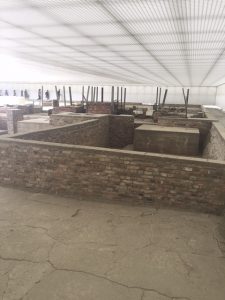
Toward the back of the camp there is a memorial dedicated to the communists. This memorial has the trademark red Communist triangles on the top, and below there is a statue depicting the Soviets freeing the German communist prisoners. This is a tribute to the liberation from fascism and it shows the communists as victims. What is interesting is that the statue originally showed the German communists as healthy and robust as the Soviets. This wasn’t accurate, and the statue was redone three times in order to paint a more “accurate” picture.

At the close of our tour, we saw the foundations of the prison within the camp. Located here was also a memorial to the homosexuals who were victimized. The plaque reads “Beaten to death, Silenced to death. In memory of the homosexual victims of National Socialism.”
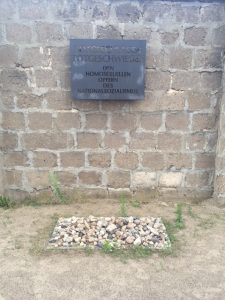
Hearts were heavy as we walked out of the camp, and as we all needed time to process what we had just experienced we were released for the rest of the afternoon. To me this was the most educational and fascinating part of our journey so far. It was a very hard day, but it was necessary not only to our knowledge of the treatment of homosexuals but in opening our eyes to the mistreatment of a wide range of people.

Very informative and given in a very personal perspective! Keep writing!
At a loss for words as I pour over your own writing of this horrific place. It is good that you witnessed this and wrote about what you saw and learned. So many times do we forget about the serious plight of others as we go on with our everyday lives – and we must never forget what happened during this period. The pure evil and diabolical, systematic maneuvers of the Nazis to wipe out Jews, Gypsies, Homosexuals, and others deemed unfit is overwhelming to digest. Thank you for sharing this experience and teaching me more so I myself do not forget.